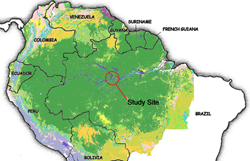All of our work in this course is in the context of sustainability and how the humanities, society, and technology can function in this domain — the spring section spent 14 weeks trying to define the concept — and our readings toward that end this summer include texts on faith and ecology, grassroots sustainability initiatives in Central America, poetry, and other explorations in imaginative, scientific, environmental, and technical communication. Today’s New York Times article on sustainability at Stony Brook University is therefore timely:
Sustainability is one of those fuzzy academic areas that varies in what it encompasses, even what it’s called. But on its philosophy there is consensus: it takes a multidimensional approach to understanding man’s interactions with the natural and man-made world, with a strong social-justice component (something environmental studies has traditionally lacked).
Across-the-curriculum sustainability was once the exclusive province of eco-colleges like Prescott in Arizona, which offers a Ph.D. in sustainability education, and the College of the Atlantic in Maine, where all students major in human ecology. But the subject has spread to mainstream colleges, as an end in itself (usually as a minor) or wrapped in another discipline (sustainability design, say, or economics).
The article appears in a “Green Revolution” special section of Education Life.
29 July 2008
We’ve read about how archeologists, ecologists, and soil scientists have studied areas around the Amazon river to try and understand the cultural and agricultural uses of biochar as long as 2,500 years ago.
An article in Discover magazine — “Black Gold of the Amazon” — discusses these contexts, and helpfully for our purposes, examples of the biomass makeup and a distinction between “smoldering” (the first step in carbon sequestration) and more traditional slash-and-burn agriculture:
The terra preta soils at Hatahara and the other sites are made from a mixture of plant refuse  and animal and fish bones, along with large quantities of charcoal that were deposited after settlers used stone axes and slow-burning fires to clear forest. Such smoldering fires produced more charcoal than ash. The charcoal, soot, and other carbon remains (collectively called biochar) retained nutrients, particularly potassium and phosphorus, that are limited in tropical soils. The resulting improvement in soil fertility may have allowed the land to support a larger, more stable crop-based population, although studies of fossilized pollen have not yet revealed the specific plants they cultivated.
and animal and fish bones, along with large quantities of charcoal that were deposited after settlers used stone axes and slow-burning fires to clear forest. Such smoldering fires produced more charcoal than ash. The charcoal, soot, and other carbon remains (collectively called biochar) retained nutrients, particularly potassium and phosphorus, that are limited in tropical soils. The resulting improvement in soil fertility may have allowed the land to support a larger, more stable crop-based population, although studies of fossilized pollen have not yet revealed the specific plants they cultivated.
In addition, soil scientist Johannes Lehmann is quoted in the article as arguing that in integrating biochar in agriculture, “you wouldn’t just be carbon neutral, you would be carbon negative, drawing carbon dioxide out of the atmosphere, producing energy and improving the climate in the process.”
24 July 2008
Posted by Michael
One of our ongoing questions is how can creating biochar be considered a carbon-negative process if we’re clearly releasing CO2 when firing our mass in the initial burning process? Jeanne Roberts, in this post on “Biochar: A Good Way to Store CO2,” summarizes that process, at least when it comes to burning wood, “as in a forest fire, only part of the CO2 is released, and the rest remains contained in the resulting charcoal…”
She states later in the article that,
Biochar is a carbon-negative addition to soils that reduces total fertilizer requirements, reduces runoff, reduces nitrous oxide emissions from crops by up to 80 percent, and enhances crop yields. The gases produced during pyrolysis can be used as fuel to create more biochar, making the process even more carbon negative.
Other scientific articles support this carbon-negative aspect, but we still need to learn about the effects when burning or smoldering compost, for example, or what some studies refer to as “agricultural waste.”


 and animal and fish bones, along with large quantities of charcoal that were deposited after settlers used stone axes and slow-burning fires to clear forest. Such smoldering fires produced more charcoal than ash. The charcoal, soot, and other carbon remains (collectively called biochar) retained nutrients, particularly potassium and phosphorus, that are limited in tropical soils. The resulting improvement in soil fertility may have allowed the land to support a larger, more stable crop-based population, although studies of fossilized pollen have not yet revealed the specific plants they cultivated.
and animal and fish bones, along with large quantities of charcoal that were deposited after settlers used stone axes and slow-burning fires to clear forest. Such smoldering fires produced more charcoal than ash. The charcoal, soot, and other carbon remains (collectively called biochar) retained nutrients, particularly potassium and phosphorus, that are limited in tropical soils. The resulting improvement in soil fertility may have allowed the land to support a larger, more stable crop-based population, although studies of fossilized pollen have not yet revealed the specific plants they cultivated.